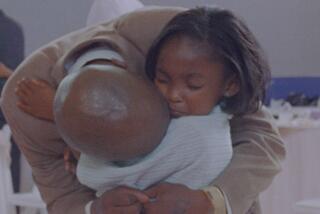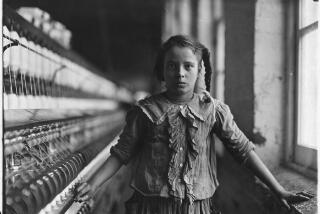One Day of ‘Take a Child to Work’ Is Short on Substance : Boys are now being invited to join the formerly all-girl event. But it’s doubtful kids find our jobs worth imitating. It may be better to just share the pride of accomplishment.
April 27 is coming up soon, time to celebrate Take a Child to Work Day. From coast to coast, Americans will bring their children along to the offices, factories, restaurants and stores where they spend most of their waking hours. There, boys and girls will discover the joys of daily labor.
In the San Fernando Valley, major employers are gearing up for the event. But in many places it is changing from its original form two years years ago. Rocketdyne, Anheuser-Busch, Litton Industries and Disney Studios are opening their doors to girls and boys .
“This will be our first year participating,” says Ken Green, a Disney spokesman. “It seemed reasonable to make it available to both genders.”
Green’s carefully worded “both genders” refers to the original Take Our Daughters to Work Day. Dreamed up by ambitious feminists and sponsored by the Ms. Foundation, it was meant to help convince girls of their right and ability to gain independence by earning their own paychecks.
In the backlash against all things politically correct, many adults have declared the original day unfair to boys. “Let boys join in the fun!” they’ve cried out.
Although a few local businesses are nostalgically sticking to the old version, some big, visible companies are making conspicuous nods toward the new correctness. Litton Industries has set aside a separate date, May 11, for boys to come in and get their fair share of observing labor.
Hailing the trend last week in a Wall Street Journal op-ed article was philosophy professor Christina Hoff Sommers. She attacked the reverse sexism of Take Our Daughters to Work Day and concluded confidently, “When the smoke clears and the mirrors lie shattered, the fair-minded and clear-headed parents, teachers and employers who are quietly acting to replace ‘Take Our Daughters to Work’ with ‘Take a Child to Work’ will have prevailed.”
Well, it’s only right. Boys too should be able to savor that rush-hour traffic, recycled high-rise air and convenience-store pastries for breakfast.
My problem with both the single-sex and the all-inclusive versions of Take a Child to Work Day is that they are too watered down to achieve the intended purpose.
The inspiration for Take Our Daughters to Work Day was a 1977 book called “The Managerial Woman” by Margaret Hennig and Anne Jardim. It reported that successful corporate females from the pre-Betty Friedan era all enjoyed the same childhood advantage: frequent trips to the office with Dad. At work, Dad explained everything he was doing. He was his daughter’s mentor. He initiated her into the mores of the business world. He took her to work a lot.
That’s a far cry from spending one day at the office where you’re treated as a curiosity, an intruder or, at best, a diverting guest.
*
Kids are too smart to feel welcome in the workaholic corridors of American power. Not only that, they rarely find what we do either glamorous or worth imitating.
My daughters, for instance, have sized up my work as a big yawn. (I celebrate Take a Child to Work Day every day, since my office is at home.)
“Mom, why do you work so much?” they’ll ask, standing in my office doorway. “It looks boring.” Well, yes, the exciting things happen in my brain.
“I work to get money,” I explain.
“What’s so great about money?”
“It buys stuff.”
But you’re so miserable, their looks tell me; look at that frown! Can it be worth it trading your life energy for stuff?
“Stuff like power-light sneakers and video games,” I add.
Ahh, they nod, and move off to watch more interesting things like the grass grow.
If my daughters grow up to be writers (God help them), it won’t be because they got fired up watching me hunker over a keyboard. It will be for what my writing earns me, and for a pride of accomplishment that I emanate. Those they can see without hanging around my office.
More to Read
Inside the business of entertainment
The Wide Shot brings you news, analysis and insights on everything from streaming wars to production — and what it all means for the future.
You may occasionally receive promotional content from the Los Angeles Times.










